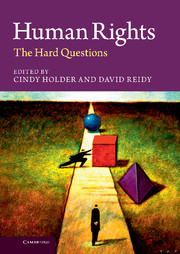Book contents
- Frontmatter
- Contents
- Figure
- List of table
- Notes on contributors
- Introduction
- Part I What are human rights?
- Part II How do human rights relate to group rights and culture?
- Part III What do human rights require of the global economy?
- Part IV How do human rights relate to environmental policy?
- 11 Human rights in a hostile climate
- 12 A human rights approach to energy, poverty and gender inequality
- 13 Pollution wolves in scientific sheep’s clothing
- Part V Is there a human right to democracy?
- Part VI What are the limits of rights enforcement?
- Part VII Are human rights progressive?
- Index
- References
13 - Pollution wolves in scientific sheep’s clothing
Why environmental-risk assessors and policy-makers ignore the “hard issues” of the human rights of pollution victims
Published online by Cambridge University Press: 05 May 2013
- Frontmatter
- Contents
- Figure
- List of table
- Notes on contributors
- Introduction
- Part I What are human rights?
- Part II How do human rights relate to group rights and culture?
- Part III What do human rights require of the global economy?
- Part IV How do human rights relate to environmental policy?
- 11 Human rights in a hostile climate
- 12 A human rights approach to energy, poverty and gender inequality
- 13 Pollution wolves in scientific sheep’s clothing
- Part V Is there a human right to democracy?
- Part VI What are the limits of rights enforcement?
- Part VII Are human rights progressive?
- Index
- References
Summary
In 1998, seven-year-old Emily Pearson died of brain cancer. She was one of 16 children living in a four-block-area of Hammond, Indiana, of all of whom (mostly toddlers) were diagnosed with rare cancers, all clearly tied to ethylene-dichloride (EDC) and vinyl-chloride releases from nearby Keil Chemicals, owned by Ferro Corporation. In 1993, the year before Emily’s diagnosis, the US Environmental Protection Agency said the local corporation was the nation’s top emitter of EDC. It predicted the Hammond facility would cause scores of new, otherwise-avoidable local cancers. After many young children died, Ferro-Keil denied responsibility but admitted annually releasing 2,000,000,000 pounds (907,184,470 grams) of EDC – only a gram of which can be fatal for a child (Shrader-Frechette 2007a, 3–7).
Apart from whether Ferro-Keil actually caused all these deaths and injuries of Indiana children, did it violate their human rights by subjecting them to high doses of known carcinogens and neurotoxins? Why is recognizing the human rights of vulnerable groups, threatened by pollution, a hard question?
- Type
- Chapter
- Information
- Human RightsThe Hard Questions, pp. 246 - 268Publisher: Cambridge University PressPrint publication year: 2013
References
- 3
- Cited by

